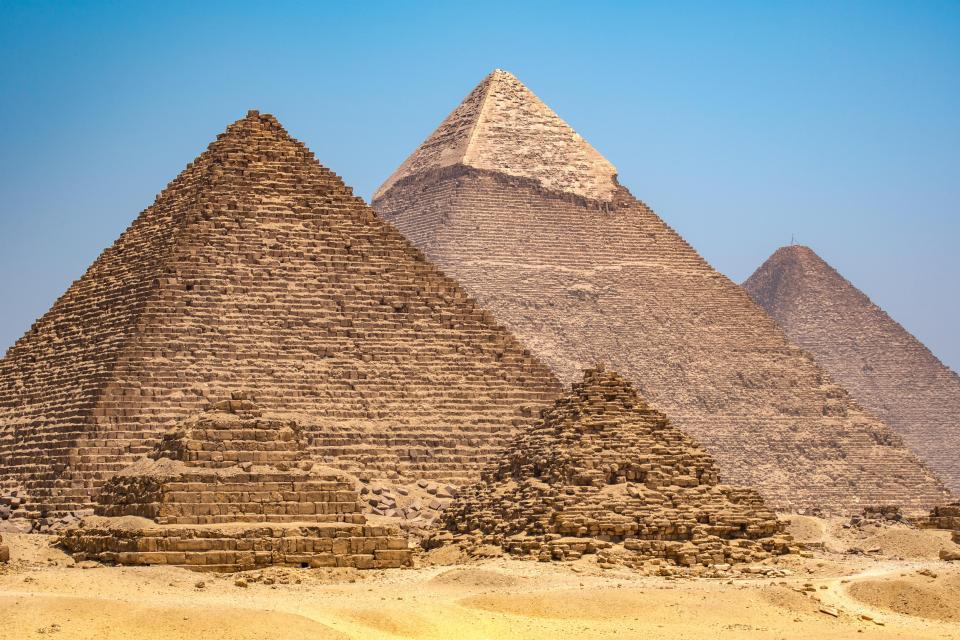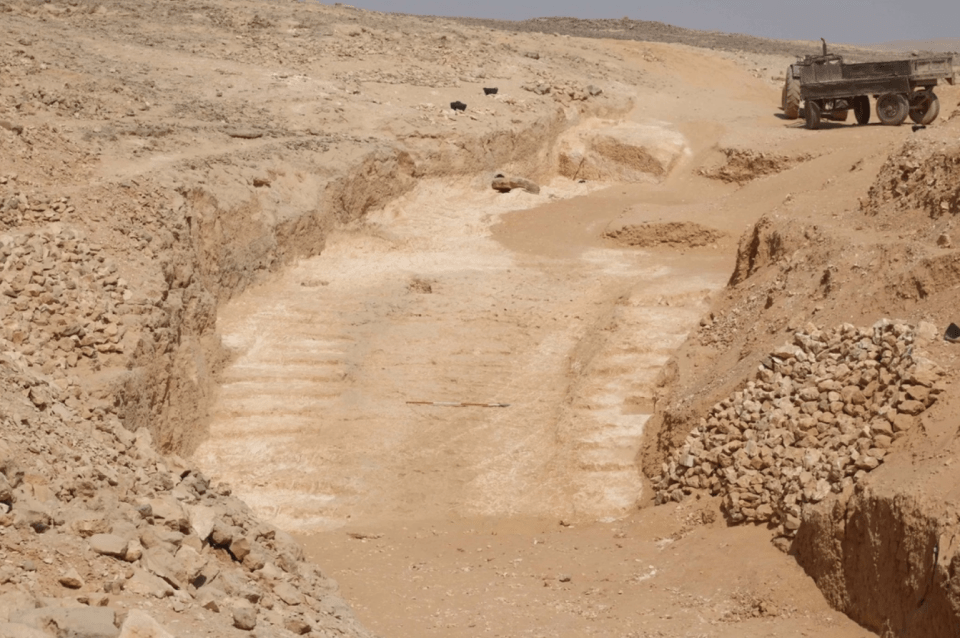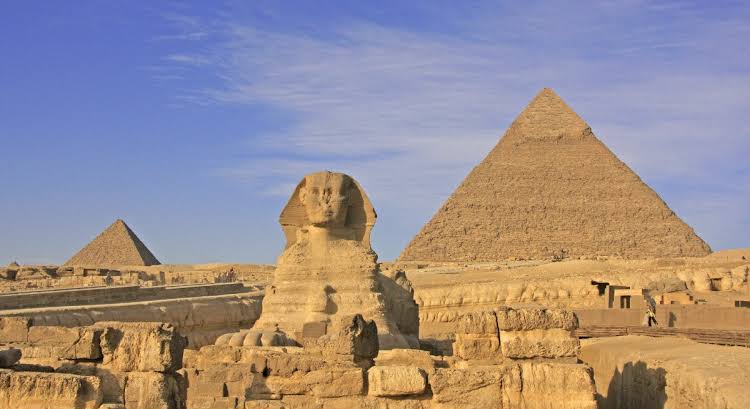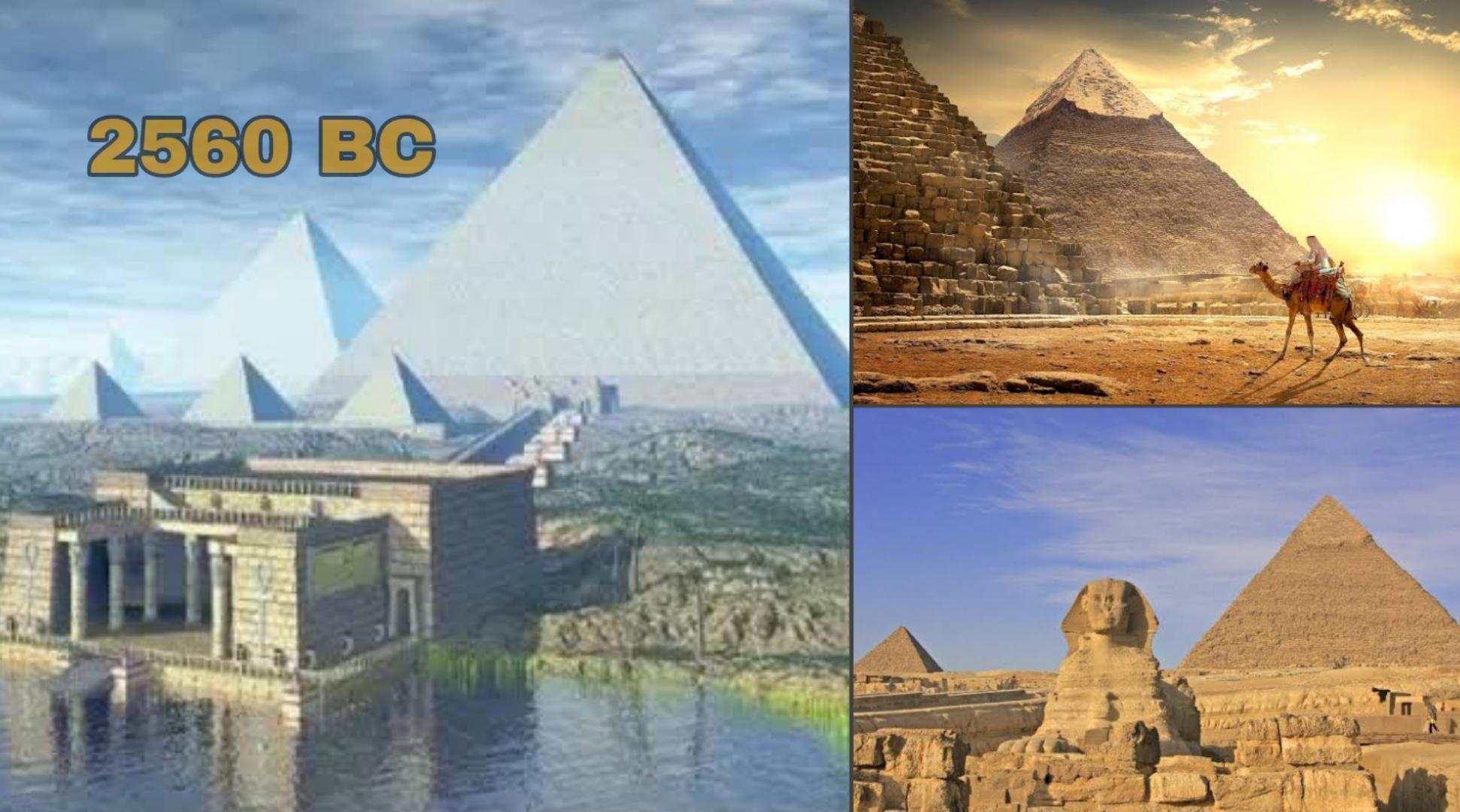The Great Pyramid of Giza (also known as the Pyramid of Khufu or the Pyramid of Cheops) is the oldest and largest of the three pyramids that make up the Giza pyramid complex, which borders modern-day Giza in Egypt. It is the oldest of the Seven Wonders of the Ancient World, as well as the only one that has been preserved in its entirety.
Historians say the pyramid was constructed over a 20-year period, finishing around 2560 BC, as a tomb for Egyptian pharaoh Khufu of the Fourth Dynasty. For more than 3,800 years, the Great Pyramid was the world’s tallest man-made building, standing at 146.5 meters (481 feet).
It is estimated to weigh about 6 million tonnes and is made up of 2.3 million limestone and granite blocks, some weighing up to 80 tonnes.

It was originally covered by limestone casing stones that formed a smooth outer surface; today, only the underlying core layer can be seen, with a few casing stones visible at the bottom. It was constructed by extracting massive stones from a quarry and raising them into place, although there are many scientific and alternative theories on how it was made.
Within the Great Pyramid, there are three known chambers. The pyramid’s lowest chamber, which was unfinished, was cut into the bedrock upon which it was constructed. Within the pyramid structure, the Queen’s Chamber and King’s Chamber are located higher up.
The main part of the Giza complex consists of a series of structures that include two mortuary temples dedicated to Khufu (one near the pyramid and one near the Nile), three smaller pyramids for Khufu’s wives, an even smaller “satellite” pyramid, an elevated causeway linking the two temples, and small mastaba tombs for nobles surrounding the pyramid.
Egyptologists believe the pyramid was built over a 20-year period as a tomb for Egyptian pharaoh Khufu (often referred to as “Cheops”) of the Fourth Dynasty. Hemiunu (also known as Hemon), Khufu’s vizier, is thought by some to be the founder of the Great Pyramid.
The Great Pyramid was originally 146.6 meters (481.0 feet) tall when it was built, but its current height is 137 meters (449.5 feet) due to the removal of its original casing. Given the absence of the casing, the lengths of the sides at the base are difficult to determine, but recent analyses place them between 230.26 meters (755.4 feet) and 230.44 meters (756.0 feet). The volume is approximately 2,300,000 cubic metres (81,000,000 cubic feet), including an internal hillock.
Egyptologist Flinders Petrie measured the pyramid for the first time in 1880–82 and reported his findings as The Pyramids and Temples of Gizeh. Many of the Great Pyramid’s casing stones and inner chamber blocks fit together with absolute accuracy. The average joint opening is just 0.5 millimetres (0.020 in) wide, according to measurements taken on the north-eastern casing stones.
For over 3,800 years, the pyramid was the world’s tallest man-made building.
The pyramid’s construction is so precise that the four sides of the base have an average error of just 58 millimetres in length. The foundation is horizontal and flat to within 15 mm (0.6 in) of being perfectly flat.
The four cardinal compass points are closely matched to the sides of the square base (within four minutes of arc) centered on true north, not magnetic north, and the finished base has a mean corner error of just 12 seconds of arc.
According to Petrie’s survey and subsequent research, the finished design measurements were originally 280 Egyptian Royal cubits high by 440 cubits long on each of the four sides of the tower.
1760/280 Egyptian Royal cubits have a perimeter to height ratio of 2 with a precision of better than 0.05 percent (corresponding to the well-known approximation of 22/7). According to some Egyptologists, this was the result of a deliberate nature proportion. Verner wrote, “We can conclude that although the ancient Egyptians could not precisely define the value of π, in practice they used it”.
“But these areas and circular ratio relations are so systematic that we can grant that they were in the builder’s design,” Petrie concluded. Others contend that the ancient Egyptians had no concept of pi and would not have thought to include it in their monuments if they did. They assume that the observed pyramid slope is the product of a simple seked slope option made without consideration for the finished building’s overall size and proportions.
The Great Pyramid is made up of 2.3 million blocks, most of which are thought to have been transported from nearby quarries. The Tura limestone for the casing was quarried on the other side of the river. The pyramid’s largest granite stones, located in the “King’s” chamber, weigh between 25 and 80 tonnes and were transported from Aswan, more than 800 kilometers (500 mi) away.
The ancient Egyptians made rough blocks of stone by hammering grooves into natural stone faces, inserting wooden wedges, and soaking them in water. The wedges grew as the water was absorbed, breaking off workable chunks.

After the blocks were removed, they were transported to the pyramid by boat, either up or down the Nile River. The Great Pyramid is thought to have been built with 5.5 million tonnes of limestone, 8,000 tonnes of granite (imported from Aswan), and 500,000 tonnes of mortar.
The Diary of Merer, written by a supervisor of the deliveries of limestone and other building materials from Tura to Giza in the final year of Khufu’s reign, was discovered in 2013 on rolls of papyrus.
White “casing stones”—slant-faced, flat-topped blocks of highly polished white limestone—were used to finish the Great Pyramid. To achieve the necessary measurements, these were neatly cut.
All that is visible today is the underlying stepped core structure. A massive earthquake in 1303 AD lowered many of the outer casing stones, which were reportedly carted away in 1356 by Bahri Sultan An-Nasir Nasir-ad-Din al-Hasan for use in nearby Cairo.
Muhammad Ali Pasha removed several more casing stones from the site in the early nineteenth century to build the upper portion of his Alabaster Mosque in Cairo, not far from Giza. The limestone casings are also visible as part of the structures. Later explorers found huge piles of rubble at the base of the pyramids left over from the casing stones’ ongoing collapse, which were cleared away during the site’s ongoing excavations.
Several casing stones from the lowest course are still in place. They exhibit the same level of craftsmanship and precision that has been noted for centuries. Petrie discovered a new orientation in the heart and casing, which measured 193 centimetres by 25 centimetres.
He indicated that after the core was constructed, a redetermination of north was made, but a mistake was made, and the casing was built with a different orientation. “To put such stones in exact contact would be diligent work,” Petrie said of the casing stones, “but to do so with cement in the joints seems almost impossible.” It has been proposed that the mortar (Petrie’s “cement”) was responsible for completing this nearly impossible task by providing a level bed that enabled the masons to precisely place the stones.
Construction theories
The preparation of the pyramid is one of the mysteries of its construction.

Many alternate, often conflicting, theories on the construction methods of the pyramid have been suggested. Others believed that slave labor was used, but modern data gathered in the nearby workers’ camps associated with construction in Giza indicate that thousands of conscript laborers were constructed instead.
Historians suggests that Ancient Egyptians used the same approach used for earlier and later constructions, laying out portions of the plan on the field on a scale of 1-to-1. He writes that “this working diagram will also help to produce the pyramid architecture with unparalleled precision by any other means.”
A modern construction management research, in collaboration with Mark Lehner and other Egyptologists, estimated that the total project needed an average workforce of approximately 13,200 people and a maximum workforce of approximately 40,000.
The authors of the study used critical path analysis methods which indicate that the Great Pyramid could have been completed from start to finish in about 10 years.
 The African History Truly African
The African History Truly African

